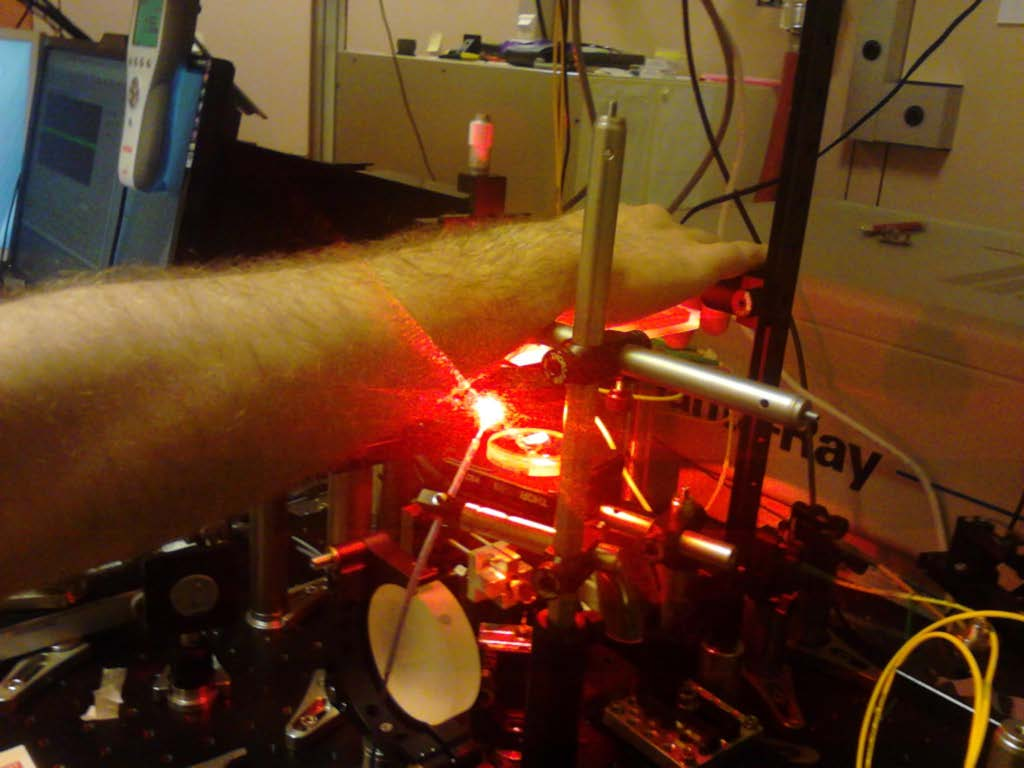Interdisciplinary Coupled Physics Imaging
This project is a follow up of the completed project on Photoacoustic Imaging in Biology and Medicine.
In collaboration with the Center of Medical Physics and Biomedical Engineering of the Medical University of Vienna, our research focuses on topics in Coupled Physics Imaging (CPI), which are mathematical modeling, computational algorithms and novel practical experimental realizations in view of applications to biomedical imaging. By combining various imaging modalities, such as Optical Coherence Tomography (OCT), Photoacoustic Tomography (PAT) and Elastography, we aim for hybrid imaging techniques that combine the advantages of each single method. Detailed mathematical modeling can support the image quality, can decrease the acquisition time, leads to new experimental realizations, and even allows for recovery of hidden parameters in CPI.
In Photoacoustical Imaging, the interior of a specimen is analyzed by illuminating it with a short laser pulse and observing the acoustic wave which is hereby induced via the photoacoustic effect. The propagation of the wave is mathematically modelled with the wave equation. Given the measurements of the acoustic wave on some detector outside of the illuminated object, one then tries to recover the initial pressure distribution which comprises information about its interior such as the optical absorption coefficient and the Grüneisen parameter.
The mathematical model of Optical Coherence Tomography is based on a simplification of Maxwell's equation. The experimental setup, illumination with plane waves, allows to reduce the mathematical problem to an inverse problem for the permittivity, which is again a functional of the optical absorption coefficient. The detailed mathematical modeling of OCT makes it transparent that the imaging functionals of Photoacoustics and OCT depend on the same quantitive functions, the optical absorption coefficient and the optical scattering coefficient. Since in OCT there is no coupling mechanism, which transforms heat into sound waves, OCT modeling does not require a Grüneisen parameter. In this sense Coupled Physics experiments for simultaneous OCT and Photoacoustic measumrements could be beneficial for quantintative imaging to reconstruct the optical absorption and/or scattering coefficient.

Project Information
Austrian Science Fund (FWF) Project P26687 - "Interdisciplinary Coupled Physics Imaging".
Contributors
Alexander Beigl, Peter Elbau, Leonidas Mindrinos, Otmar Scherzer, Julian Schmid
Collaborators
Wolfgang Drexler, Mengyang Liu and Behrooz Zabihian, Center of Medical Physics and Biomedical Engineering of the Medical University of Vienna
Selected Publications
- P. Elbau and O. Scherzer. Modelling the Effect of Focusing Detectors in Photoacoustics Sectional Imaging. SIAM J. Imaging Sciences, 8(1):1-18, 2015.
- T. Glatz, O. Scherzer and T. Widlak. Texture Generation for Photoacoustic Elastography. J. Math. Imaging Vision, 52(3):369-384, 2015.
- J. Schmid, B. Zabihian, T. Widlak, T. Glatz, M. Liu, W. Drexler and O. Scherzer. Texture Generation in Compressional Photoacoustic Elastography. Proceedings of SPIE, Photons Plus Ultrasound: Imaging and Sensing, Vol. 9323, 2015.
